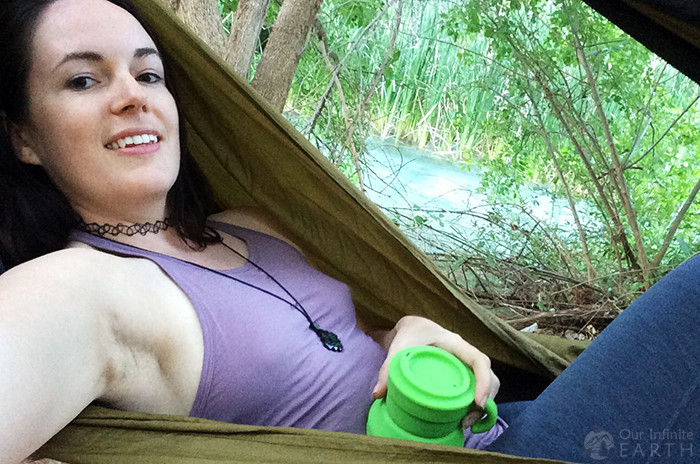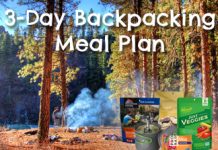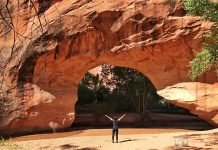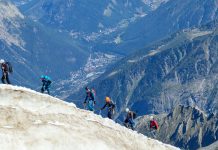

Essential Backpacking Gear For Any Location
This is your standard essential gear that will always be with you on every trip.
Trail Backpack: Osprey Backpack
I just got an Osprey Atmos 65 backpacking pack from REI and I love it! It comes with a day pack inside the pack that can be fully removed, hydration sleeve, and rain cover. It’s also light weight and has lots of padding.
- Weight: 3.7lbs
Tent: Big Agnes
- Weight: 2lbs, 6oz
- Fits two people
- Push button LED lights incorporated into the seams of the tent.
Sleeping bag
- One Person: Helio Sleeping Bag
- Weight: 1lb, 9oz
- Rated for 55 degrees
- Two People Who Like To Cuddle: Sleepingo Double Sleeping Bag
- Weight: 3lbs
- Rated for 55 degrees
Sleeping mat: Inflatable DownMat
- Weight: 1lbs 5oz.
- Radiates your body heat back to you.
Hydration Bladder: Platypus Reservoirs
- Weight: 3.2 oz.
Headlamp: Black Diamond Headlamp
- Weight: 3.25 oz. (with batteries)
- Waterproof
- Red night vision and strobe modes
Day Pack
If you are planning to set up camp and then go on day hikes from that location. My backpacking pack comes with a removable day pack, so which makes this really convenient and easy.
Safety Equipment & Tools
First Aid Kit: Adventure Medical Kits
- Weight: Less than 1.5 lbs.
Mirror & Whistle: 7-in-1 Survival Tool
- Weight: 1.6 oz.
If you have a regular mirror and whistle just laying around, that’s great too. This one comes with a few more accessories. You never know where you’re going to be if you’re stuck and need help. With no cell service and unable to move, this whistle is louder and uses less energy than your voice and the mirror can be used to signal for help from miles away.
Leatherman/ Knife: TTI Multi-Tool
- Weight: 8.2 oz.
Backpacking Kitchen Gear
Stove: Large Camping Burner
- Weight: 9.6 oz.
Fuel Canister: Coleman Fuel Canister
Double check that this matches with your stove before heading out!
Lighter
Bring multiple just in case something happens to the first one.
Cook ware: HUKOER Camping Mess Kit
Utensils: Stainless Steel Sporks
- Weight: .8 oz.
- Comes with a case
Filtration/purification Tablets: Package of 30
- Weight: .9 oz.
- Destroys viruses and bacteria in 15 min., Giardia in 30 min. and Cryptosporidium in 4 hrs.
- Use 1 tablet per quart of water


Mug: Silicone Collapsible Camping Mugs
- Weight: 5 oz.
- Keeps beverages hot or cold
Food Vault
Trash bag/ Storage: Trash Dry Sack
- Weight: 3.5 oz.
- Odor free handy trash storage
Empty Water Jug
If camping near a water source, bring an empty jug that you can then fill with water and purify with your tablets.
Backpacking Food
There is a wide variety of food options when you’re backpacking or camping. It’s really all up to your personal preference and tastes.
Toiletries
Toothpaste & Brush: Travel Kit with Case
Deodorant
Sunscreen: Neutrogena SPF 110
Bug Spray
Chap stick/Lip Balm: Botanica SPF 25
Wipes: Biodegradable wipes
Hand sanitizer
If no latrines are available:
Toilet paper and ziplock bag
Sanitation Trowel: GSI Trowel
Read more about the principles of Leave No Trace »
WAG Bag: Toilette in a Bag
I’m seeing this more and more that you are required to carry out all human waste and some places will not provide you with a WAG bag, you must bring your own.
Clothing for Backpacking
Bring only the essentials that you absolutely need in your pack. Also, aim for quick-drying fabrics that don’t hold in moisture.
Hiking boots
While on my last backpacking trip the heels of my hiking boots literally fell off, so I’m searching for my next amazing pair. Thus far I’m using Lowa Ferrox GTX, which are working great! They’re VEGAN (no leather), waterproof, and breathable, which covers all of my needs.
If you don’t know where to start shopping for boots, read this guide on how to choose the best hiking boot for you.
Hiking socks
Many great options available on REI and Amazon or your local outdoor store. Find what feels best for you with your boots. Avoid Cotton since it doesn’t breath and absorbs moisture. I’m a fan of these light Smartwool socks.
Camp shoes/ flip flops
Something comfortable to wear around camp other than your hiking boots. I really like these Rubber Sole Mesh Water Shoes.
Down (or other warm) jacket: Nano Lightweight Jacket By 32 Degrees
My mom bought me this jacket for Christmas and it’s been great. I wear it day-to-day and on my trip to Iceland and Peru. Its light enough that it’s not too hot when unzipped, but also nice and toasty when zipped. It’s also fairly form fitting and flattering and is slightly water resistant. Most importantly, 32 Degrees is has a Responsible Down Standard certification, ensuring that the down does not come from any animals subjected to unnecessary harm such as force feeding or live plucking.
Rain Top: Stretch Anorak Waterproof Jacket By 32 Degrees
Comfortable, form fitting, and does a good job of keeping out water. I particularly like the stretch material so that you don’t feel confined when wearing it.
Rain Pants: Side Zip Rain Pants
Not something I often use, but when you need then, you’ll be glad you have them! I like since it makes it easier to get them on and off, especially when wet.
Sports bra
Since I’m fairly small chested and will double my swim suit top for this if bringing my swim suit anyway. There are several good options available from REI.com
Tank top/ Tshirt
Something out of your closet that’s comfortable and form fitting. If you want to be “super pro” about it, you can go for a wicking shirt to keep moisture away from your body.
Long sleeve layer
I just like to use a regular thin long-sleeve shirt for this and then layer a tank-top under it if I get cold. Something similar to this long underwear top. If backpacking in cold weather, you might want to consider a Smartwool zip up jacket instead.
Shorts or legging: Beyond Yoga Leggings
I generally prefer leggings to protect my legs from getting cut up on dried grass or branches or from walking through poison oak. Beyond Yoga has a great variety of fashionable and functional leggings.
Warm hat
Hats are a great way to regular your body temperature without having to remove lots of layers. Any ski hat will be sure to keep you warm even in cold weather.
Sunglasses/ shade hat
Underwear
Sleeping clothes & comfy socks
I personally like to keep a “clean” pair of clothes and comfy socks to change into when sleeping that I haven’t been wearing outdoors and haven’t gotten sweaty. This can be any sort of comfy PJ tops and bottoms depending on the temperature.
Camera Gear/ Electronics
Honestly, camera phones have gotten so good, that you can use for the majority of your travels and get some amazing photos. Especially if you have a selfie stick and a lens kit. But for those looking for something more advanced:
Go Pro: HERO 5
I haven’t used this particular GoPro, however it shoots in 4k and is waterproof up to 10meter without a case. GoPros are amazing cameras specifically geared for ourdoor use.
DSLR: Canon Rebel T6i
I’ve had a T3i for years and it’s no longer made by the manufacturer, but this is the newest version of that same camera, which is probably better than mine.
Battery Charger: Portable Quick Charger
- Weight: 6.4 oz.
- 4x faster than other chargers
Music
Extras
Some additional items you might want to have depending on personal preferences and the location where you’re hiking.
Trekking Poles: TrailBuddy
I know lots of people swear by trekking poles. Personally, I generally prefer to go without, but I rented a pair from REI for a Mt. Baldy hike and was glad to have them. So I think poles really depend on where you’re hiking – if it’s a steep grade or uneven footing, then poles come in very handy. There are lots of much more expensive options out there than these, but if you’re just getting started or don’t use them often like me, these are a good option.
Lantern
I really like to bring a lantern since it’s nice to have a light source at camp that’s not a flashlight or headlamp. The inflatable solar lights are so light, they’re easy to just throw in your pack.
- Strong Illumination: Collapsible LED Camping Lantern
- Weight: 12.8 oz
- Battery Life: 12 hours
- Low Light Ambiance: Inflatable Solar Lantern
- Weight: 4oz
- Lasts 12 hours on a full 8 hour charge
I personally prefer low light lanterns since the strong LED lights can get in the way of seeing the stars. I was very impressed with this inflatable solar lantern. It worked better than I thought it would and lasted all night.
Dish soap
If you want to wash your dishes rather than just rinse them out. Use an old travel shampoo/conditioner bottle and refill it with dish soap. You’ll only need a very small amount.
Small sponge
Cut a normal sponge in half – that’s all you’ll need.
Snake Bit Kit: Extraction Kit
Just in case, when hiking in the desert.
Black Light Flashlight: Infray Blacklight
Did you know that scorpions glow in blacklights? Like really really glow. If you’re hiking in the desert, it’s a good idea to use one of these so that you don’t accidentally step on one and to check your shoes!
Water Shoes: Quick Drying Water Shoes
If you’re going to be walking through a lot of water or down a river, these are a must!
Neoprene Socks: By FunToes
Goes with the water shoes to keep your feet from getting cold when walking in cold water for miles.
GPS/ Navigational Device: Garmin
Depending on where you’re hiking this could come in handy. There are some very expensive options out there for GPS devices. This is one is more middle of the road and covers the basics of what you’d need.




